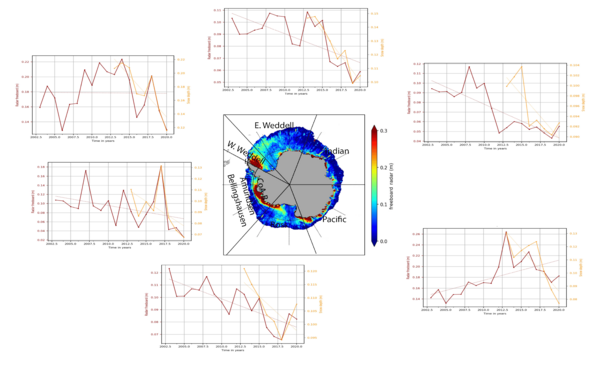Sea ice variations around Antarctica
Image of the Month - September 2023
Sea ice around Antarctica has seen its lowest maximum extent on record (since 1978) this southern winter 2023, while for a long time the continent and surrounding sea ice were considered as mostly stable.
However, in order to assess that an maximum extent is the lowest, time series as long as possible have to be computed and made available. Passive microwave satellite observations provide with a more than 40 year old record. And extent is one parameter, but thickness is another important one, that altimeters can retrieve - both laser and radar altimeters, through the determination of sea ice freeboard and snow depth.
Such datasets have been produced over the 2003-2020 period (and will be updated soon up to 2023 - keep in touch!). In that time, sea ice thickness has decreased of about 10 % per decade on average, with interannual variability - 2015 saw a slight increase, while 2016 showed a strong decrease, and continued afterwards even if the extent increased. Regional variations can also be observed, with the Amundsen-Bellingshausen sea ice thickness re-increasing after 2016.
All these variations are probably the signature of significant ongoing changes in the Antarctic sea ice, and should continue to be monitored. The current constellation of altimeter satellites should be complemented by 2027 by Cristal (aka Sentinel-9), an ice-observation dedicated satellite from the Copernicus Programme.
See also:
- Image of the Month, October 2021: Snow on ice
- Data: altimetry sea ice datasets from CTOH (soon updated up to 2023!)
- Missions: Cryosat-2
- Applications: Sea ice
Reference:
- Garnier, F., M. Bocquet, S. Fleury; J. Bouffard, M. Tsamados, F. Remy, G. Garric, A. Chenal, 2022: Latest Altimetry-Based Sea Ice Freeboard and Volume Inter-Annual Variability in the Antarctic over 2003–2020. Remote Sens. 2022, 14, 4741. https://doi.org/10.3390/rs14194741





